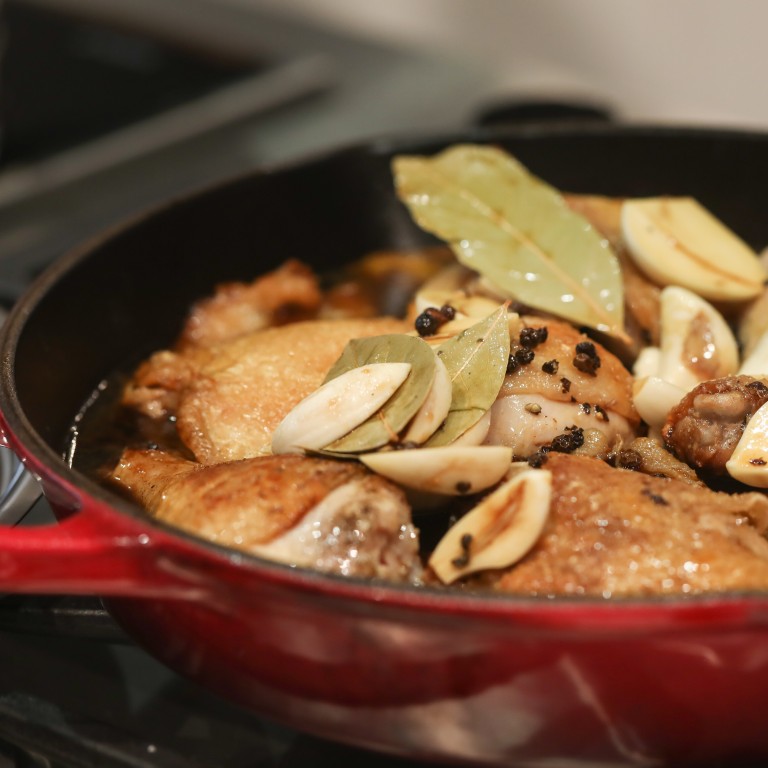
Is Philippines’ adobo recipe debacle akin to spats over Italy’s pizza, Spain’s paella?
- Filipinos are ridiculing officials over their plans to pin down a recipe for adobo, a dish that virtually every family has a different take on
- But while the ingredients people choose to use may differ, the best version of adobo is cooked just the way you like it
The Philippines has a national bird, national flower, national costume, but no official national dish. Foreigners are likely to associate “Jollibee” with Filipinos, while locals would cite adobo as one of the country’s most famous dishes.
The meal – which typically features pork or chicken with garlic and peppercorns, marinated and simmered in soy sauce and vinegar – is such a staple that many Filipino households have their own family recipes.
Which was why there was swift backlash and derision towards the Department of Trade and Industry (DTI) when it said last week that it would set a standard recipe for adobo and other popular Filipino dishes to improve their global marketability.
Philippine government seeks to standardise recipe for adobo, prompting backlash
People wondered: Doesn’t the government have better things to do than to regulate adobo? What will officials do if I don’t follow the standards – arrest me?
Jokes began surfacing on social media. One cartoon, circulated on Twitter, shows two inmates seated in a large jail cell. A menacing guy asks the weedy fellow beside him: “What you in for?” The inmate replies, “Adobo”.
The last panel of the cartoon shows the burly inmate has moved to the other side of the cell, away from the heinous food violator.
The adobo furore even sparked speculation by some people that it was a government plot to divert public attention from the latest scandals.
Faced with a storm of criticism, the DTI hastily clarified it wasn’t laying down mandatory standards for cooking adobo, but was trying to arrive at a “traditional” recipe it could promote internationally.
Who would have thought adobo would cause such an outcry? Come to think of it, though, I’ve read of quarrels in Spain about how to prepare cocido and paella; arguments in France about salad niçoise. And of course the Italians are famously touchy about carbonara and pizza.
But here’s the thing: adobo isn’t really a recipe, it’s a description. Everyone and their mother or father have their own version.
The name itself is foreign – probably given by Spanish colonisers who found the dish very similar to something they prepared back home. Europe has a tradition of cooking meat in wine or vinegar and garlic (I have an alleged Italian recipe for stewing chicken with white wine, garlic and rosemary).
The most widely known version of adobo is simple to prepare: you simmer the meat in soy sauce, vinegar, garlic and peppercorn. Then you remove the meat, fry it in low heat, add the sauce and braise.
It’s a recipe based on tantiya – estimation. A relative of mine studying abroad once eagerly accosted a visiting aunt for her adobo recipe, asking: “How much soy sauce and vinegar should I use?” The aunt replied: “I can’t tell you, you have to judge and taste it.”
Different families have different ingredient proportions. Some add sugar. Some serve it with lots of sauce, others with almost none.
Has the Filipino diaspora fuelled Jollibee’s global growth?
Simple as it is, adobo has a taste that keeps people coming back for more. Years ago, a German friend who went to Boracay related how he felt famished after a bracing swim in the sea, and found himself ravenously digging into mounds of rice and cold adobo. “Now I understand why it’s so popular,” he said.
Another German friend I took around the old walled city of Intramuros insisted on eating in a carinderia for students – literally a hole in the wall – and trying some of the greasy adobo with thick chunks of fatty pork, while I watched in morbid fascination. He swore he loved it. He also likes our sweet longganisa pork sausages.
But what he ate was just one type of adobo. There’s a version that features whole hard-boiled eggs; another does without the soy sauce and uses coconut cream. A Filipina living in Europe wrote on Facebook that she always cooked adobo with potatoes and her German husband loved it.
My version uses chicken and goes the soy sauce route, but adds red wine and a little water. I fry the chicken and garlic with paprika. I cooked this in Berlin and a close friend, a gourmand, said: “This chicken is excellent.”
Why do I use that recipe? Because I like it that way. My fellow Filipinos cook their adobo how they like – sweet, salty, dry, with laurel leaves, with beef, fish, vegetables. There’s even adobo canned tuna available in the supermarkets.
Adobo can appear in a family meal, picnic, cafeteria, or party. I remember someone telling me how, during the 1970s, she and her family would go to a cinema and watch a film while eating from a bucket of adobo and rice.
That cloying garlic smell must have been something. But the other film-goers probably did not mind because they were digging into their own containers of spicy beef caldereta stew. It’s probably why up to now, movie houses in malls sternly admonish patrons: no rice meals allowed.


